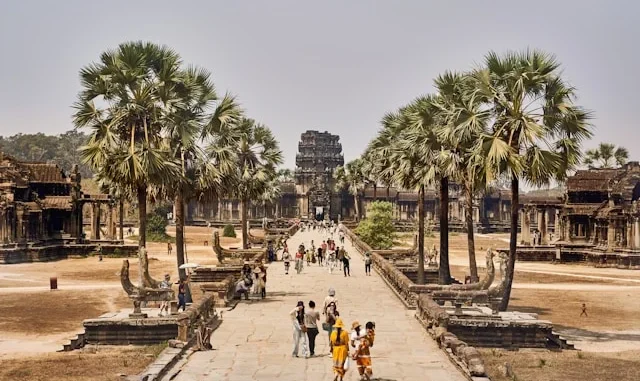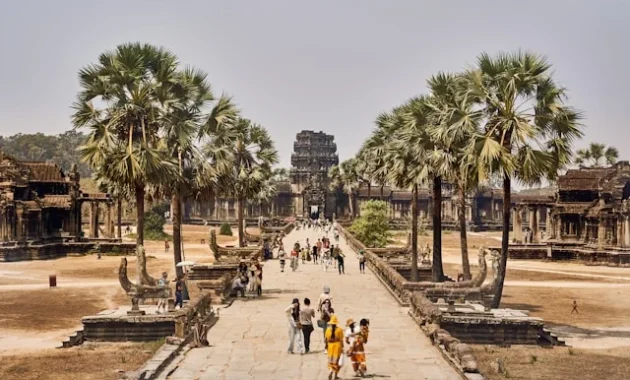
Angkor Wat, nestled in the heart of Cambodia, stands as a testament to the architectural prowess and cultural richness of the Khmer Empire. This sprawling temple complex, recognized as the largest religious monument in the world, draws millions of visitors annually, all eager to witness its majestic beauty and delve into its historical significance. Angkor Wat is not just a symbol of Cambodia; it is a symbol of human ingenuity and spiritual devotion.
Historical Background: The Rise of the Khmer Empire
Angkor Wat, originally constructed in the early 12th century by King Suryavarman II, was initially dedicated to the Hindu god Vishnu. This shift from the traditional worship of Shiva marked a significant change in the religious landscape of the region. The temple complex, built over three decades, exemplifies the peak of Khmer architecture with its grandeur and intricate carvings.
The Khmer Empire, at its zenith, was a dominant force in Southeast Asia, encompassing modern-day Cambodia, Thailand, Laos, and southern Vietnam. Angkor Wat served not only as a religious center but also as a political and cultural hub. The city of Angkor, with its extensive network of temples, reservoirs, and canals, highlights the advanced engineering and urban planning of the Khmer civilization.
Architectural Marvels: Design and Symbolism
The architecture of Angkor Wat is a stunning blend of form and function, infused with deep religious symbolism. The complex is designed to represent Mount Meru, the sacred mountain in Hindu mythology considered to be the center of the universe. The five central towers symbolize the mountain’s five peaks, and the surrounding moat represents the cosmic ocean.
The Layout and Structure
The temple is constructed on a raised terrace above the rest of the city, symbolizing its elevated spiritual status. The central tower, rising 65 meters above ground, is surrounded by four smaller towers at the corners, creating a quincunx pattern. This arrangement is not only aesthetically pleasing but also imbued with symbolic meaning, reflecting the Hindu cosmology.
Intricate Carvings and Bas-Reliefs
Angkor Wat is renowned for its extensive and detailed bas-reliefs, covering the walls and depicting various Hindu epics and historical events. These carvings provide a window into the rich cultural and religious life of the Khmer people. Notable scenes include the churning of the ocean of milk, the battle of Kurukshetra from the Mahabharata, and the exploits of King Suryavarman II.
The Transition to Buddhism: A Temple Reimagined
By the end of the 12th century, Angkor Wat transitioned from a Hindu temple to a Buddhist one, reflecting the changing religious landscape of the region. This transformation did not diminish its significance; rather, it enhanced the temple’s spiritual aura, making it a pilgrimage site for Buddhists.
Buddhist Influence on Art and Architecture
The Buddhist influence is evident in the addition of numerous Buddha statues and the transformation of existing Hindu icons. The serene face of Buddha can be seen in various corners of the temple, blending seamlessly with the Hindu deities, showcasing a harmonious blend of two great religions.
Exploring Angkor Wat: Must-See Attractions
The Central Tower
Climbing to the top of the central tower, visitors are rewarded with a panoramic view of the entire complex and the surrounding landscape. This vantage point offers a unique perspective on the temple’s scale and grandeur.
The Western Entrance
The main entrance to Angkor Wat is through the western gate, a magnificent structure flanked by two large pools. This entrance is symbolic, as it faces west towards Vishnu, and provides a dramatic introduction to the complex.
The Libraries and Courtyards
Scattered throughout the temple complex are several libraries and courtyards. These spaces were used for various religious and administrative purposes and are adorned with intricate carvings and sculptures.
The Surrounding Temples: An Extended Journey
While Angkor Wat is the centerpiece, the surrounding temples in the Angkor Archaeological Park are equally mesmerizing. Notable temples include:
Bayon Temple
Famous for its smiling stone faces, Bayon is a striking example of Buddhist architecture. Each of its towers is adorned with four faces, believed to represent the Bodhisattva Avalokiteshvara.

Ta Prohm
Known as the “Tomb Raider Temple” due to its appearance in the popular movie, Ta Prohm is engulfed by massive tree roots, creating a unique and otherworldly atmosphere. This temple is a vivid reminder of the power of nature and the passage of time.
Banteay Srei
Located further from the main complex, Banteay Srei is renowned for its exquisite carvings and pink sandstone construction. This temple, dedicated to the Hindu god Shiva, showcases some of the finest artistry in Angkor.
Conservation Efforts: Preserving a Heritage Site
Preserving Angkor Wat for future generations is a complex and ongoing effort. The temple faces numerous challenges, including weathering, vegetation overgrowth, and the impact of tourism.
Restoration Projects
Several international organizations have collaborated with the Cambodian government to undertake extensive restoration projects. These efforts aim to stabilize the structures, repair damaged carvings, and prevent further deterioration.
Sustainable Tourism Practices
Promoting sustainable tourism is crucial to preserving Angkor Wat. Visitors are encouraged to follow guidelines that minimize their impact on the site, such as staying on designated paths, not touching the carvings, and respecting the cultural heritage.
Conclusion: A Timeless Journey
Exploring Angkor Wat is a journey through time, offering a glimpse into the grandeur of the Khmer Empire and the spiritual devotion that has endured through the centuries. This ancient wonder continues to inspire awe and reverence, drawing visitors from around the world to its sacred grounds.